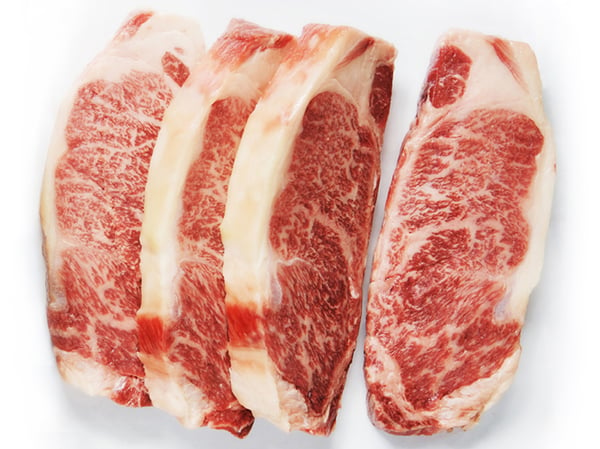
If you thought the fake news circulated only in political circles, guess again—some of the biggest myths and misinformation out there are about the food we love.
Did you know that, despite what people say, Bourbon can be made outside of Kentucky, as long as it’s made in the U.S.? Have you heard the one about Wagyu and Kobe beef and how they can be called “Wagyu” and “Kobe” only if they’re exported straight out of Japan? Is that actually true and accurate?
You’ve got meaty myths; we’ve got the chops to debunk them. Let’s dig in!
Myth #1: You can’t purchase authentic Wagyu beef in the U.S.
This meat misinformation has been perpetuated by some pretty high-profile chefs, including Michael Mina, and we need to set this one straight.
The Facts
There are four different breeds of Wagyu, which translates from Japanese as “Japanese cow.” Although these breeds originated in Japan, Wagyu beef cattle can be born and raised anywhere in the world, and the Wagyu designation is verified through genetic testing to verify purity of Japanese lineage.
Debunking the Myth
So, although the USDA did have a ban on the import of Japanese beef—including Japanese Wagyu—from 2009 to 2012 in order to keep foot-and-mouth disease at bay, that doesn’t mean there weren’t any Wagyu cattle in the U.S. In fact, the first Wagyu cattle arrived in the U.S. from Japan in 1975, and we transitioned our entire herd to Wagyu back in 2008—so don’t let anyone tell you Wagyu beef is new to the U.S. or that you can’t get it here. You can. We sell it.
Myth #2: American Wagyu isn’t the same as Japanese Wagyu.
According to Chef Gerald Chin, “Domestic Wagyu and Japanese Wagyu are completely different in terms of taste and texture.” Sorry, Chef Chin, but that’s not exactly accurate.
The Facts
Yes, many American ranchers crossbreed their Wagyu cattle with Angus cattle. And yes, USDA regulations require only 46.9 percent Wagyu genetics for beef sold at retail. But this doesn’t mean you can throw crossbred, purebred, and fullblood Wagyu—whether in the U.S. or Japan—into the same bucket and make generalizations about flavor, quality, texture, and taste.
Debunking the Myth
The biggest difference between Wagyu cattle raised in Japan and those raised domestically in the U.S. comes down to incubation. In Japan, they hold cattle in tiny spaces with roughly five to seven steer in pens the size of your average living room for their entire lives. At Lone Mountain, our Wagyu beef cattle are raised on 1,500- to 2,000-acre ranges for the first half of their lives. How much or little the cattle move around impacts marbling—the more they move, the less marbling the beef will have.
Because of this difference in how most U.S. ranchers raise their cattle, the top 10 percent of crossbred American Wagyu comes pretty close in quality to that of fullblood domestic Wagyu and even some Japanese Wagyu.
Myth #3: Kobe beef in the U.S. is a huge sham and a big lie.
All Kobe beef is Wagyu, but not all Wagyu is Kobe. Think of Kobe as the Champagne of beef. After all, Champagne can be designated as such only if it was made using chardonnay, pinot noir, or pinot meunier in the region of Champagne, France. If you think you’re drinking Champagne made in California wine country, it’s not really Champagne. The same goes for Kobe. But is Kobe beef a sham, as Bon Appetit suggests, or a “big lie,” as this Forbes article asserts? Not exactly.
The Facts
Kobe beef comes from a handful of closely monitored Japanese Black Wagyu cattle in Japan’s Hyōgo Prefecture. That’s pretty specific. After these cows are slaughtered in designated slaughterhouses, the meat is heavily graded and measured on firmness, texture, luster, quality, marbling, and more. Only the very best meat will be certified Kobe with an official seal and identification number to trace it to its origin point.
According to Bon Appetit, the amount of authentic Kobe that arrives in the U.S. each year is enough to feed just 77 meat-loving Americans. So how are there so many restaurants serving Kobe beef Sliders and Kobe meatballs and Kobe kibbeh?
Debunking the Myth
In order to sustainably make use of the entire animal, a lot of Wagyu cuts end up in the grind. It’s a necessity. Sometimes restaurants label the grind as Kobe, and the best restaurants are transparent and have ground Wagyu on the menu—not Kobe.
Despite Larry Olmsted’s suggestion that the American Wagyu Association create a new designation called “Great Great American Beef” or to call it “Japanese-style beef,” this isn’t likely to happen.
Myth #4: Wagyu is Wagyu is Wagyu.
It bears repeating, because this is one of the biggest, most commonly perpetuated myths out there: If they say it’s Wagyu, then it’s Wagyu, right?
The Facts
Wagyu beef cattle originated in Japan and, according to some, have genes that originated tens of thousands of years ago. However, up until the late 19th century, Wagyu weren’t bred for consumption because of a ban on eating meat. Once the ban was lifted, cattle were imported from around the world and crossbred with Wagyu.
The Japanese Wagyu breeds we know—and test lineage for—today were locked in 1910, when crossbreeding stopped in Japan. The result of this process:
- Crossbred Wagyu: Although crossbreeding stopped in Japan more than a century ago, crossbreeding is common throughout the world. In the U.S., Wagyu are most frequently crossbred with the Angus breed.
- Purebred Wagyu: This designation goes to Wagyu cattle that have been genetically tested and have at least 93.75 percent Japanese Wagyu lineage.
- Fullblood Wagyu: This designation goes to Wagyu cattle that have been genetically tested and are of 100 percent Japanese Wagyu lineage.
Debunking the Myth
Of the roughly 30,000 Wagyu-influenced cattle in the U.S., 85 percent were crossbred, and fewer than 5,000 are fullblood Wagyu!
The lesson here is that you’ve got to pay attention to where your Wagyu is coming from, especially with short articles like this in The New York Times out there that don’t tell what type of Wagyu the proprietors are selling.
(By the way, in that NYT article, the two companies the author mentions sell almost completely crossbred Wagyu, but you wouldn’t know it by reading the article.)
Beyond the myths
Have we cleared up the top myths about Wagyu in the U.S. and the realities of Wagyu versus Kobe for you? This post offers up even more clarification about the difference between Kobe and Wagyu, too.
You can avoid the fake news and half truths by doing your due diligence and asking questions of your beef sellers about their Wagyu lineage, raising practices, and more to make sure you’re getting what you want—and what you’re paying for. With Lone Mountain Wagyu, you can trust that you’re always getting 100 percent fullblood Wagyu beef humanely raised right here in the United States.






